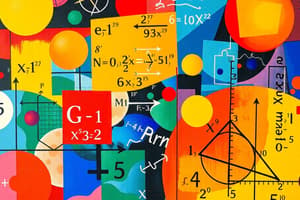Podcast
Questions and Answers
What is the sum of the interior angles of a hexagon?
What is the sum of the interior angles of a hexagon?
- 1260°
- 900°
- 1080°
- 720° (correct)
In the context of functions, what does the notation f'(x) represent?
In the context of functions, what does the notation f'(x) represent?
- The area under the curve of f(x)
- The minimum value of f(x)
- The average rate of change of f(x)
- The derivative of f(x) (correct)
What is the correct expression of the sine function in a right triangle in relation to its sides?
What is the correct expression of the sine function in a right triangle in relation to its sides?
- Opposite side divided by hypotenuse (correct)
- Hypotenuse divided by adjacent side
- Opposite side divided by adjacent side
- Adjacent side divided by hypotenuse
Which of the following expressions best represents the limit definition of a derivative?
Which of the following expressions best represents the limit definition of a derivative?
What is the probability of rolling a total of 7 with two six-sided dice?
What is the probability of rolling a total of 7 with two six-sided dice?
Flashcards are hidden until you start studying
Study Notes
Key Concepts in Mathematics
1. Basic Arithmetic
- Operations: Addition, subtraction, multiplication, division
- Order of Operations: PEMDAS (Parentheses, Exponents, Multiplication and Division (left to right), Addition and Subtraction (left to right))
2. Algebra
- Variables: Symbols representing numbers (e.g., x, y)
- Equations: Mathematical statements asserting equality (e.g., 2x + 3 = 7)
- Functions: Relationships between sets of numbers (e.g., f(x) = x^2)
3. Geometry
- Shapes and Properties:
- Triangles: Types (isosceles, equilateral, right); sum of angles = 180°
- Circles: Key terms (radius, diameter, circumference = πd)
- Polygons: Sum of interior angles = (n-2) × 180°, where n is the number of sides
4. Trigonometry
- Functions: Sine (sin), cosine (cos), tangent (tan)
- Right Triangle Relationships: a^2 + b^2 = c^2 (Pythagorean theorem)
- Unit Circle: Defines trig functions for angles in radians
5. Calculus
- Limits: Approach of a function as it nears a point
- Derivatives: Measure of how a function changes as its input changes; f'(x) = lim (h→0) [f(x+h) - f(x)]/h
- Integrals: Area under a curve; ∫f(x)dx
6. Statistics
- Descriptive Statistics: Mean, median, mode, range
- Probability: Likelihood of an event occurring; P(A) = Number of favorable outcomes / Total outcomes
- Distributions: Normal distribution, binomial distribution
7. Number Theory
- Prime Numbers: Natural numbers greater than 1 with no positive divisors other than 1 and itself
- Factors and Multiples: Factorization, least common multiple (LCM), greatest common divisor (GCD)
8. Mathematical Reasoning
- Logical Statements: Conditional statements (if-then), negation, conjunctions, disjunctions
- Proof Techniques: Direct proof, proof by contradiction, induction
9. Mathematical Modeling
- Applications: Using mathematics to represent real-world situations
- Equations and Inequalities: Used for optimization and prediction
Additional Topics
- Matrix Operations: Addition, multiplication, determinants, inverses
- Set Theory: Definitions of sets, subsets, unions, intersections
- Graph Theory: Vertices, edges, paths, cycles, and networks
Study Tips
- Practice problem-solving regularly
- Understand concepts rather than rote memorization
- Utilize visual aids (graphs, diagrams) for better comprehension
- Review and solve past exam questions for preparation
Key Concepts in Mathematics
Basic Arithmetic
- Operations include addition, subtraction, multiplication, and division.
- Follow the order of operations: PEMDAS (Parentheses, Exponents, Multiplication and Division from left to right, Addition and Subtraction from left to right).
Algebra
- Variables (e.g., x, y) represent numbers and are used in equations.
- Equations express mathematical equality, such as 2x + 3 = 7.
- Functions define relationships between numbers, exemplified by f(x) = x^2.
Geometry
- Triangles include types such as isosceles, equilateral, and right; the sum of angles in any triangle is always 180°.
- Key terms in circles: radius, diameter, and circumference, which is calculated as π times the diameter (πd).
- The sum of interior angles in polygons is (n-2) × 180°, where n represents the number of sides.
Trigonometry
- Fundamental functions are sine (sin), cosine (cos), and tangent (tan).
- The Pythagorean theorem relates the sides of a right triangle: a² + b² = c².
- The unit circle aids in defining trigonometric functions for angles measured in radians.
Calculus
- Limits describe the value a function approaches as it nears a specific point.
- Derivatives indicate how a function changes with respect to its input, formulated as f'(x) = lim (h→0) [f(x+h) - f(x)]/h.
- Integrals calculate the area beneath a curve, represented as ∫f(x)dx.
Statistics
- Descriptive statistics summarize data using measures like mean, median, mode, and range.
- Probability measures the likelihood of an event occurring, calculated as P(A) = Number of favorable outcomes / Total outcomes.
- Common distributions include the normal distribution and the binomial distribution.
Number Theory
- A prime number is defined as a natural number greater than 1 with no divisors other than 1 and itself.
- Factors and multiples involve concepts like factorization, least common multiple (LCM), and greatest common divisor (GCD).
Mathematical Reasoning
- Logical statements include conditional statements (if-then), as well as concepts of negation, conjunctions, and disjunctions.
- Common proof techniques are direct proof, proof by contradiction, and mathematical induction.
Mathematical Modeling
- Involves applying mathematics to represent and solve real-world situations.
- Equations and inequalities are utilized for optimization and making predictions in various contexts.
Additional Topics
- Matrix operations include addition, multiplication, finding determinants, and calculating inverses.
- Set theory includes understanding definitions of sets, subsets, unions, and intersections.
- Graph theory focuses on vertices, edges, paths, cycles, and networks in mathematical structures.
Study Tips
- Regular practice in problem-solving enhances comprehension and skill.
- Emphasis on understanding concepts leads to better retention than memorization.
- Visual aids, such as graphs and diagrams, support successful learning.
- Reviewing past exam questions is valuable for effective preparation.
Studying That Suits You
Use AI to generate personalized quizzes and flashcards to suit your learning preferences.




